#Mustela erminea
Text
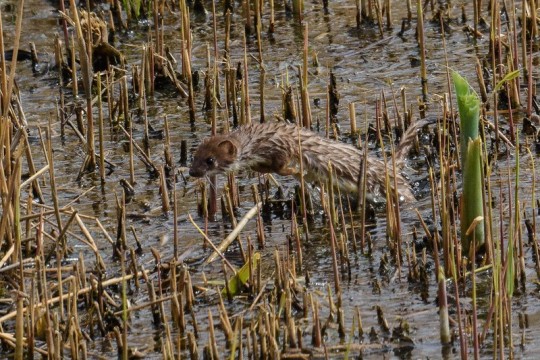
A stoat (Mustela erminea) leaps through the marshes in Suffolk, UK
by Barbara Evans
#stoat#weasels#mustelids#mustela erminea#mustela#mustelidae#carnivora#mammalia#chordata#wildlife: uk#wildlife: europe#wildlife: england
626 notes
·
View notes
Text

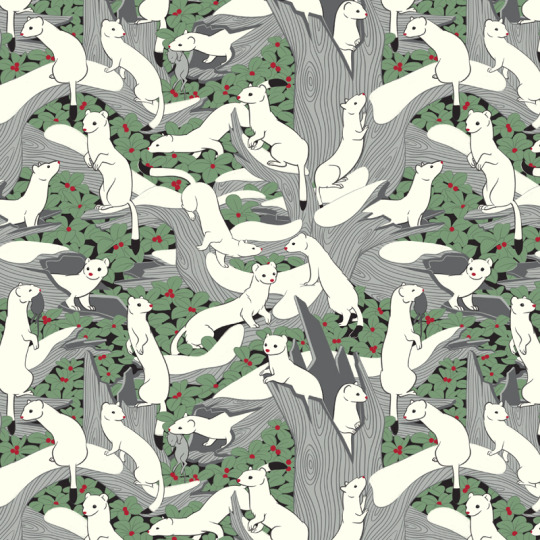

Happy Solstice! Here's a caravan of stoats in their winter finery, for the occasion.
#stoat#weasel#mustelid#ermine#short-tailed weasel#illustration#jada fitch#art#maine#drawing#nature#design#artist#Mustela erminea#Mustelidae#teaberry#Gaultheria procumbens#American wintergreen#checkerberry#boxberry#groudcover#pattern#fabric pattern#pattern design#repeating#stump#hollow log#winter#christmas card#forest
570 notes
·
View notes
Photo

Stoat
117 notes
·
View notes
Text
Yak Carpgills
A stoat, born in an ordinary family of fisherbeasts, since his cubhood unwilling to change his coat from winter white to summer brown. He angered Firstmarten, he defeated Sunken Dread, he can breathe underwater and was awarded with a constellation of his own - this is all Yak Carpgills - the patron saint of fisher-folk and those mustelids whose life and activities are connected with water.

Do you know why in Bluedawning the dawns are blue?
Like a petal of a forget-me-not flower, falling on an emerald leaf, Vazhyan Lake sparkles in its green framing. At dawn a blue mist rises from azure waters, and the sun rises above this eye of the forest, piercing the clouds of mist with its cool rays. As if shrouded in a blue shawl, the Sun rises higher and higher, and then throws it down onto the green covering.
Few of the beasts now remember that the beautiful blue haze over the lake is the blood of Sunken Dread, still evaporating from the surface of its waters.
There once lived a saber-tooth with a greedy heart. She fooled and robbed many animals for gold. And in the end, she paid for it. They poisoned her food with sleeping herbs, tied her up and threw her into the Vazhyan Lake.
The saber-toothed cat drowned, but she could not get to the Underworld, as she was supposed to. Her body fell into the thick silt and got stuck in it. Even her soul was held back by this thick underwater tar. Her spirit could not go to the Skynesting, and it remained with her bones.
Thanks to her iron will and the desire to survive at all costs, her soul made the dead body move again, although it took many years to try. In time, the body grew flesh, and Bluedawning gained a monster named Sunken Dread, devouring anything it could get its fangs on.
Young Yaxi never liked changing his coat from winter to summer, and wanted to be of a shiny white color all his life. It never happened, and he complained and whined to Firstmarten, and scolded her, and destroyed her idols, trying to get her attention. One day, his wish came true. One winter, Yak stood before Firstmarten's idol and gazed at her dangling beady eyes. He always began his desecration with those. Yaxi rushed at the beads, but suddenly a sheaf of ash burst from behind the wooden head and engulfed the stoat's head and neck. "Now you will have the same coat in both summer and winter," a voice rang in his ears. So Yaxi remained ugly - white with a black head and neck. And he never shed his coat again. In summer all prey saw him from a mile away. In winter it was a little easier, when he could pretend to be a black twig sticking out of snow. But since then, his life has gone awry.

So he decided to make amends to the Skynesting. He went to search for a heroic deed to perform, but he didn't have to go far. There was a monster swimming right in Vazhyan Lake that was hunting the locals. It took a lot of strength, intelligence and time to figure out how to defeat the saber-toothed creature. And he did it. The finally dead Dread sank to the bottom, and now nothing prevented it from going to the afterlife. As a reward, the ermine took away Sunken Dread's eyes, which shrank many times and revealed an amazing magic: the one who carries them can breathe underwater. It is believed that this is because they retain a part of the iron will of the saber-tooth. Its flesh scattered in myriad pieces, and Vazhyan absorbed its blue color forever.
The fish reappeared in Vazhyan Lake, and the beasts of the water began fishing again. Yaxi, who was named Yak Carpgills after his feat, helped them for the rest of his life and protected the lake. He also invented many different tackles and baits to make fishing easier.
He never changed his coat like an ordinary ermine, but all his life he apologized to the FirstMarten and made idols for her. Because of his coloring, Yak was not good at hunting, and this played a significant role in his choice of fishing as a way of living.
#mirolapye#mirolapye:YakCarpgills#mirolapye:SunkenDread#mirolapye:Bluedawning#worldbuilding#xenofiction#animal fiction#art#artists on tumblr#writeblr#writers on tumblr#stoat#ermine#Mustela erminea
8 notes
·
View notes
Text
Stoat (Mustela erminea)

The stoat, a small mustelid related to the weasel and otter, usually has a chestnut-coloured body and a black-tipped tail, though in colder climates its winter coat is white, like this stoat in snowy Upper Bavaria, Germany. More than just a cute creature, stoats are incredibly successful hunters. Their long, thin shape enables them to pursue prey both above and below ground, though they’re most often found in rough grassland, around rabbit burrows. They have an acute sense of smell and can travel more than two kilometres on a hunting expedition. You won’t only find them on the ground – their agility means they will also climb trees and walls to reach birds’ nests.
4 notes
·
View notes
Text
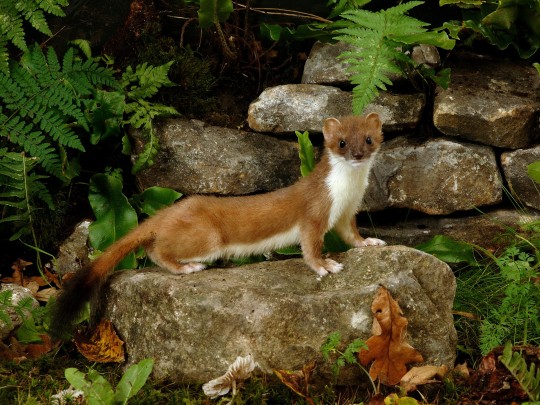
📷 A stoat showing off its characteristic black-tipped tail. © Nature Picture Library/Getty

📷 A stoat in its white winter coat. (Ermine) �� Fabrizio Moglia/Getty
Isle of Orkney to Eradicate Stoats (Mustela erminea) by 2027
"A project to eradicate Stoats from Orkney could take another five years and may require a further £8 million to complete."
"Stoats, thought to be widespread in mainland Britain, were unknown in the Northern Isles until 2010."
"The Orkney Native Wildlife Project began trapping the mammals in 2019 and has so far removed more than 5,000 individuals. The mustelids ... pose a significant threat to breeding seabirds and waders, as well as the native Orkney Vole."

#stoat#stoats#ermine#Mustela erminea#mustelids#invasive species#orkney#scotland#nature#wildlife#scottish colloquium
12 notes
·
View notes
Text
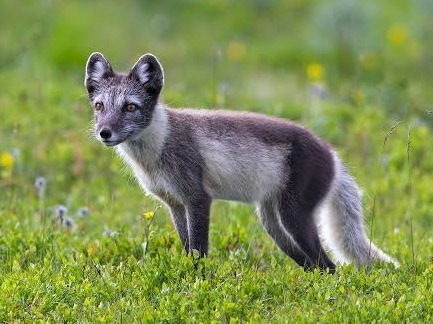

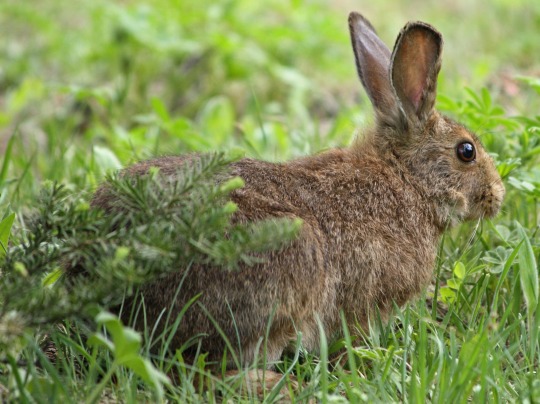



i love animals that change colours in winter it's awesome it's like a real life shiny ... so cutes
#stoats are so cute what the hell#☆#🐯#arctic fox (vulpes lagopus)#fav#snowshoe hare (lepus americanus)#stoat (mustela erminea)#vulpes#leporid#musteloid#canid
2 notes
·
View notes
Text
#ShortTailedWeasel
Ermine, Stoat or Short-tailed Weasel (Mustela erminea) in its winter coat...
She's the one who has been having fun stealing Jack's (The Raven) meat, for a long time. I've been trying to capture her for about 3 years on my camera and finaly succeeded last Thurday during the snow storm when power was down.
I'm very proud… she's an adorable one.
#Ermine#Stoat#Short-tailed Weasel#Ravens#Wildlife Need Protection#IUCN#International Union for Conservation of Nature#ECCC#Environment and Climate Change Canada#FeederWatch#Count Feeder Birds for Science#NCC#Nature Conservancy of Canada#Nature Photography#Nature Canada#Wild Bird Photography#Wildlife Photography#Animal Photography#Mountainous Parts of the Northern Hemisphere#Canada#The RavenKeeper
203 notes
·
View notes
Text

Stoat (Mustela erminea)
A Natural History of British and Foreign Quadrupeds. Written by James H. Fennell. 1843.
Internet Archive
212 notes
·
View notes
Text

Stoat (Mustela erminea)
Photo © jacsworld
640 notes
·
View notes
Text

Ermine
Alyson Bell
from the website:
The ermine species found on Haida Gwaii is endemic and has been isolated for the last 300.000 years. It is a subspecies under the name Mustela Erminea Haidarum. It loses its summer colours every year to better camouflage itself in the snow. The ermine is a beautiful and transformative being.
52 notes
·
View notes
Text



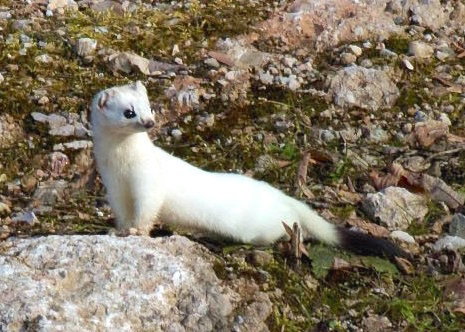
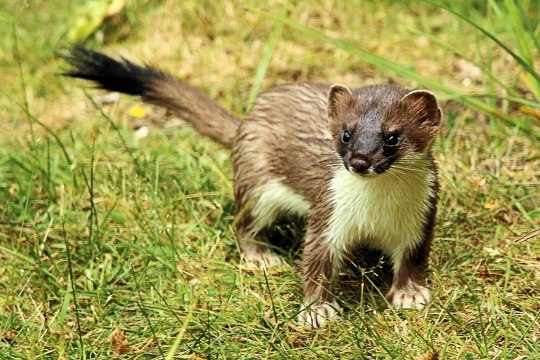





Stoats (Mustela erminea) from Wikimedia Commons.
108 notes
·
View notes
Text
Uncharismatic Fact of the Day
What’s the difference between an ermine and a stoat? Nothing-- they’re the same animal! Stoats have sandy-brown fur in the summer, and in the winter they moult into their pure white coat. It’s only when they have this coat that they’re called ermines.
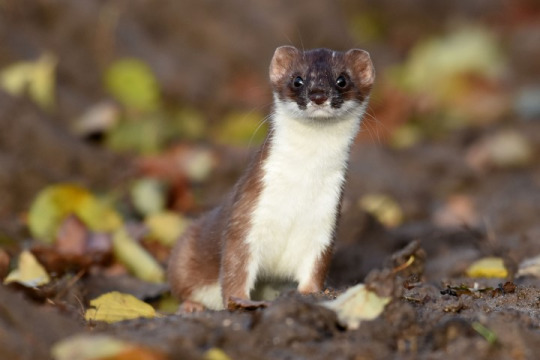
(Image: An ermine (Mustela erminea) in its summer coat by Nick Appleton)
If you like what I do, consider leaving a tip or buying me a ko-fi!
139 notes
·
View notes
Text
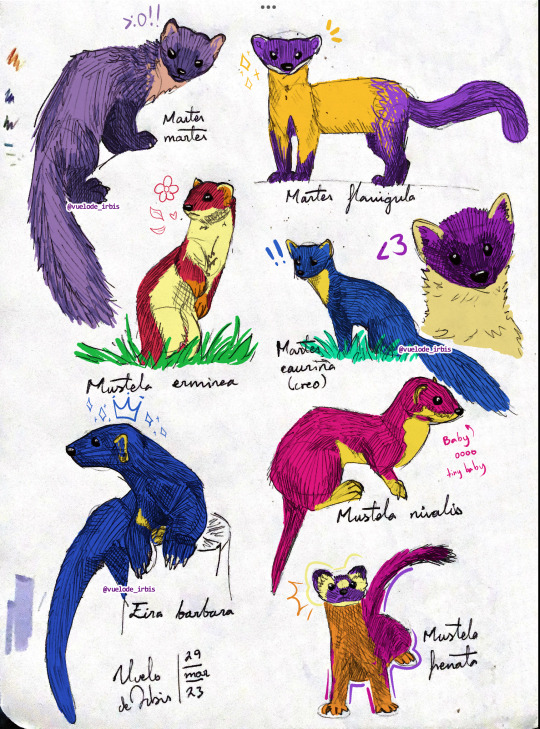
Mustelids I drew traditionally and colored digitally <3
references from pinterest
ID: a scanned photo of a page with mustelids drawn traditionally with a pen, and colored digitally with saturated colors. Each individual has their scientific name written below. From left to right and downwards, there are european pine marten (Martes martes), in purple and peach pink; yellow-throated marten (Martes flavigula) in yellow and purple; ermine (Mustela erminea) in pinkish red and cream; pacific marten (Martes caurina) in blue and yellow, and a portrait of the same species in purple and cream; tayra (Eira barbara) in blue and yellow; weasel (Mustela nivalis) in pink and yellow, and long-tailed weasel (Mustela frenata) in dark pink, orange, purple and cream. End ID.
#irbis draws#been obsessed with mustelids lately i hope i draw more of them#animal art#mustelids#mustelidae#marten#pine marten#yellow throated marten#ermine#stoat#weasel#tayra#long tailed weasel#tradtional art#sketchbook
89 notes
·
View notes
Text
All animal species (and a couple algae) that have kept the same scientific name since Linnaeus
The first work of taxonomy that is considered as having any scientific authority for animal species was the 10th edition of Linnaeus' Systema Naturae, published in 1758. (Also a book on spiders called Aranei Suecici, published one year before.) That's the foundational text of the binominal system of nomenclature of species still in use today. Since then most of Linnaeus' original species (4379 species, of which 185 mammals, 554 birds, 217 "amphibians" (including reptiles and cartilaginous fish), 379 fishes, 2104 "insects" (including various arthropods, of which 664 are beetles and 543 are moths & butterflies crammed into only 3 genera), and 940 "worms" (including basically all other invertebrates, and even some protists and algae)) have been dismembered, renamed, or at least moved to different genera (e.g. the house sparrow went from Fringilla domestica to Passer domesticus).
Here is a list of all of Linnaeus' original species from 1758 that still retain their original name. I believe they are 484 in total.
"Mammalia"
(Primates)
Homo sapiens (human)
Lemur catta (ring-tailed lemur)
Vespertilio murinus (rearmouse bat)
(Bruta)
Elephas maximus (Asian elephant)
Trichechus manatus (West Indian manatee)
Bradypus tridactylus (three-toed sloth)
Myrmecophaga tridactyla (giant anteater)
Manis pentadactylus (Chinese pangolin)
(Ferae)
Phoca vitulina (harbor seal)
Canis familiaris (dog)
Canis lupus (grey wolf)
Felis catus (house cat)
Viverra zibetha (Indian civet)
Mustela erminea (stoat)
Mustela furo (ferret)
Mustela lutreola (European mink)
Mustela putorius (wild ferret)
Ursus arctos (brown bear)
(Bestiae)
Sus scrofa (wild boar/pig)
Dasypus septemcinctus (seven-banded armadillo)
Dasypus novemcinctus (nine-banded armadillo)
Erinaceus europaeus (European hedgehog)
Talpa europaea (European mole)
Sorex araneus (common shrew)
Didelphis marsupialis (common opossum)
(Glires)
Rhinoceros unicornis (Indian rhinoceros)
Hystrix brachyura (Malayan porcupine)
Hystrix cristata (crested porcupine)
Lepus timidus (common hare)
Castor fiber (European beaver)
Mus musculus (house mouse)
Sciurus vulgaris (red squirrel)
(Pecora)
Camelus dromedarius (dromedary camel)
Camelus bactrianus (Asian camel)
Moschus moschiferus (musk deer)
Cervus elaphus (red deer)
Capra hircus (goat)
Capra ibex (Alpine ibex)
Ovis aries (sheep)
Bos taurus (cow)
Bos indicus (zebu)
(Belluae)
Equus caballus (horse)
Equus asinus (donkey)
Equus zebra (mountain zebra)
Hippopotamus amphibius (hippopotamus)
(Cete)
Monodon monoceros (narwhal)
Balaena mysticetus (bowhead whale)
Physeter macrocephalus (sperm whale)
Delphinus delphis (common dolphin)
"Aves"
(Accipitres)
Vultur gryphus (Andean condor)
Falco tinnunculus (common kenstrel)
Falco sparverius (sparrowhawk)
Falco columbarius (pigeonhawk)
Falco subbuteo (Eurasian hobby)
Falco rusticolus (gyrfalcon)
Strix aluco (tawny owl)
Lanius excubitor (great grey shrike)
Lanius collurio (red-backed shrike)
Lanius schach (long-tailed shrike)
(Picae)
Psittacus erithacus (grey parrot)
Ramphastos tucanus (white-throated toucan)
Buceros bicornis (great hornbill)
Buceros rhinoceros (rhinoceros hornbill)
Crotophaga ani (smooth-billed ani)
Corvus corax (raven)
Corvus corone (carrion crow)
Corvus frugilegus (rook)
Corvus cornix (hooded crow)
Coracias oriolus (golden oriole)
Coracias garrulus (European roller)
Gracula religiosa (hill myna)
Paradisaea apoda (greater bird-of-paradise)
Cuculus canorus (common cuckoo)
Jynx torquilla (wryneck)
Picus viridis (green woodpecker)
Sitta europaea (Eurasian nuthatch)
Merops apiaster (European bee-eater)
Merops viridis (blue-throated bee-eater)
Upupa epops (Eurasian hoopoe)
Certhia familiaris (Eurasian treecreeper)
Trochilus polytmus (red-billed streamertail hummingbird)
(Anseres)
Anas platyrhynchos (mallard duck)
Anas crecca (teal duck)
Mergus merganser (common merganser)
Mergus serrator (red-breasted merganser)
Alca torda (razorbill auk)
Procellaria aequinoctialis (white-chinned petrel)
Diomedea exulans (wandering albatross)
Pelecanus onocrotalus (great white pelican)
Phaeton aethereus (red-billed tropicbird)
Larus canus (common gull)
Larus marinus (great black-backed gull)
Larus fuscus (lesser black-backed gull)
Sterna hirundo (common tern)
Rhynchops niger (black skimmer)
(Grallae)
Phoenicopterus ruber (American flamingo)
Platalea leucorodia (Eurasian spoonbill)
Platalea ajaia (roseate spoonbill)
Mycteria americana (wood stork)
Ardea cinerea (grey heron)
Ardea herodias (blue heron)
Ardea alba (great egret)
Scolopax rusticola (Eurasian woodcock)
Charadrius hiaticula (ringed plover)
Charadrius alexandrinus (Kentish plover)
Charadrius vociferus (killdeer plover)
Charadrius morinellus (Eurasian dotterel)
Recurvirostra avosetta (pied avocet)
Haematopus ostralegus (Eurasian oystercatcher)
Fulica atra (Eurasian coot)
Rallus aquaticus (water rail)
Psophia crepitans (grey-winged trumpeter)
Otis tarda (great bustard)
Struthio camelus (ostrich)
(Gallinae)
Pavo cristatus (Indian peafowl)
Meleagris gallopavo (wild turkey)
Crax rubra (great curassow)
Phasianus colchicus (common pheasant)
Tetrao urogallus (western capercaillie)
(Passeres)
Columba oenas (stock dove)
Columba palumbus (wood pigeon)
Alauda arvensis (Eurasian skylark)
Sturnus vulgaris (European starling)
Turdus viscivorus (mistle thrush)
Turdus pilaris (fieldfare thrush)
Turdus iliacus (redwing thrush)
Turdus plumbeus (red-legged thrush)
Turdus torquatus (ring ouzel)
Turdus merula (blackbird)
Loxia curvirostra (crossbill)
Emberiza hortulana (ortolan bunting)
Emberiza citrinella (yellowhammer)
Emberiza calandra (corn bunting)
Fringilla coelebs (common chaffinch)
Motacilla alba (white wagtail)
Motacilla lava (yellow wagtail)
Parus major (great tit)
Hirundo rustica (barn swallow)
Caprimulgus europaeus (European nightjar)
"Amphibia"
(Reptiles)
Testudo graeca (Greek tortoise)
Draco volans (flying dragon)
Lacerta agilis (sand lizard)
Rana temporaria (common frog)
(Serpentes)
Crotalus horridus (timber rattlesnake)
Crotalus durissus (tropical rattlesnake)
Boa constrictor (common boa)
Coluber constrictor (eastern racer)
Anguis fragilis (slowworm)
Amphisbaena alba (red worm lizard)
Caecilia tentaculata (white-bellied caecilian)
(Nantes)
Petromyzon marinus (sea lamprey)
Raja clavata (thornback ray)
Raja miraletus (brown ray)
Squalus acanthias (spiny dogfish)
Chimaera monstrosa (rabbitfish)
Lophius piscatorius (anglerfish)
Acipenser sturio (sea sturgeon)
Acipenser ruthenus (sterlet sturgeon)
"Pisces"
(Apodes)
Muraena helena (Mediterranean moray)
Gymnotus carapo (banded knifefish)
Trichiurus lepturus (cutlassfish)
Anarhichas lupus (Atlantic wolffish)
Ammodytes tobianus (lesser sandeel)
Xiphias gladius (swordfish)
Stromateus fiatola (blue butterfish)
(Jugulares)
Callionymus lyra (common dragonet)
Uranoscopus scaber (stargazer)
Trachinus draco (greater weever)
Gadus morhua (Atlantic cod)
Blennius ocellaris (butterfly blenny)
Ophidion barbatum (snake cusk-eel)
(Thoracici)
Cyclopterus lumpus (lumpsucker)
Echeneis naucrates (sharksucker)
Coryphaena equiselis (pompano)
Coryphaena hippurus (dorado)
Gobius niger (black goby)
Govius paganellus (rock goby)
Cottus gobio (European bullhead)
Scorpaena porcus (black scorpionfish)
Scorpaena scrofa (red scorpionfish)
Zeus faber (John Dory)
Pleuronectes platessa (European plaice)
Chaetodon striatus (banded butterflyfish)
Chaetodon capistratus (foureye butterflyfish)
Sparus aurata (gilt-head bream)
Labrus merula (brown wrasse)
Labrus mixtus (cuckoo wrasse)
Labrus viridis (green wrasse)
Sciaena umbra (brown meagre)
Perca fluviatilis (European perch)
Gasterosteus aculeatus (three-spined stickleback)
Scomber scombrus (Atlanti mackerel)
Mullus barbatus (red mullet)
Mullus surmuletus (surmullet)
Trigla lyra (piper gurnard)
(Abdominales)
Cobitis taenia (spined loach)
Silurus asotus (Amur catfish)
Silurus glanis (Wels catfish)
Loricaria cataphracta (suckermouth catfish)
Salmo carpio (Garda trout)
Salmo trutta (brown trout)
Salmo salar (Atlantic salmon)
Fistularia tabacaria (bluespotted cornetfish)
Esox lucius (northern pike)
Argentina sphyraena (European argentine)
Atherina hepsetus (Mediterranean sand smelt)
Mugil cephalus (flathead mullet)
Exocoetus volitans (tropical flying fish)
Polynemus paradiseus (Paradise threadfin)
Clupea harengus (Atlantic herring)
Cyprinus carpio (common carp)
(Branchiostegi)
Mormyrus caschive (bottlenose elephantfish)
Balistes vetula (queen triggerfish)
Ostracion cornutus (longhorn cowfish)
Ostracion cubicus (yellow boxfish)
Tetraodon lineatus (Fahaka pufferfish)
Diodon hystrix (spot-fin porcupinefish)
Diodon holocanthus (long-spine porcupinefish)
Centriscus scutatus (grooved shrimpfish)
Syngnathus acus (common pipefish)
Syngnathus pelagicus (pelagic pipefish)
Syngnathus typhle (broad-nosed pipefish)
Pegasus volitans (longtail seamoth)
"Insecta"
(Coleoptera)
Scarabaeus sacer (sacred scarab)
Dermestes lardarius (larder beetle)
Dermestes murinus (larder beetle)
Hister unicolor (clown beetle)
Hister quadrimaculatus (clown beetle)
Silpha obscura (carrion beetle)
Cassida viridis (tortoise beetle)
Cassida nebulosa (tortoise beetle)
Cassida nobilis (tortoise beetle)
Coccinella trifasciata (ladybug)
Coccinella hieroglyphica (ladybug)
[Coccinella 5-punctata, 7-punctata, 11-punctata, and 24-punctata survive as quinquepunctata, septempunctata, undecimpunctata, and vigintiquatorpunctata]
Chrysomela populi (leaf beetle)
Chrysomela lapponica (leaf beetle)
Chrysomela collaris (leaf beetle)
Chrysomela erythrocephala (leaf beetle)
Curculio nucum (nut weevil)
Attelabus surinamensis (leaf-rolling weevil)
Cerambyx cerdo (capricorn beetle)
Leptura quadrifasciata (longhorn beetle)
Cantharis fusca (soldier beetle)
Cantharis livida (soldier beetle)
Cantharis oscura (soldier beetle)
Cantharis rufa (soldier beetle)
Cantharis lateralis (soldier beetle)
Elater ferrugineus (rusty click beetle)
Cicindela campestris (green tiger beetle)
Cicindela sylvatica (wood tiger beetle)
Buprestis rustica (jewel beetle)
[Buprestis 8-guttata survives as octoguttata]
Dytiscus latissimus (diving beetle)
Carabus coriaceus (ground beetle)
Carabus granulatus (ground beetle)
Carabus nitens (ground beetle)
Carabus hortensis (ground beetle)
Carabus violaceus (ground beetle)
Tenebrio molitor (mealworm)
Meloe algiricus (blister beetle)
Meloe proscarabaeus (blister beetle)
Meloe spec (blister beetle)
Mordela aculeata (tumbling glower beetle)
Necydalis major (longhorn beetle)
Staphylinus erythropterus (rove beetle)
Forficula auricularia (common earwig)
Blatta orientalis (Oriental cockroach)
Gryllus campestris (field cricket)
(Hemiptera)
Cicada orni (cicada)
Notonecta glauca (backswimmer)
Nepa cinerea (water scorpion)
Cimex lectularius (bedbug)
Aphis rumici (black aphid)
Aphis craccae (vetch aphid)
Coccus hesperidum (brown scale insect)
Thrips physapus (thrips)
Thrips minutissimum (thrips)
Thrips juniperinus (thrips)
(Lepidoptera)
Papilio paris (Paris peacock butterfly)
Papilio helenus (red Helen butterfly)
Papilio troilus (spicebush swallowtail butterfly)
Papilio deiphobus (Deiphobus swallowtail butterfly)
Papilio polytes (common Mormon butterfly)
Papilio glaucus (eastern tiger swallowtail butterfly)
Papilio memnon (great Mormon butterfly)
Papilio ulysses (Ulysses butterfly)
Papilio machaon (Old World swallowtail butterfly)
Papilio demoleus (lime swallowtail butterfly)
Papilio nireus (blue-banded swallowtail butterfly)
Papilio clytia (common mime butterfly)
Sphinx ligustri (privet hawk-moth)
Sphinx pinastri (pine hawk-moth)
[genus Phalaena was suppressed, but seven subgenera created by Linnaeus are now valid as genera]
(Neuroptera)
Libellula depressa (chaser dragonfly)
Libellula quadrimaculata (four-spotted skimmer dragonfly)
Ephemera vulgata (mayfly)
Phryganea grandis (caddisfly)
Hemerobius humulinus (lacewing)
Panorpa communis (scorpionfly)
Panorpa germanica (scorpionfly)
Raphidia ophiopsis (snakefly)
(Hymenoptera)
Cynips quercusfolii (oak gall wasp)
Tenthredo atra (sawfly)
Tenthredo campestris (sawfly)
Tenthredo livida (sawfly)
Tenthredo mesomela (sawfly)
Tenthredo scrophulariae (sawfly)
Ichneumon extensorius (parasitoid wasp)
Ichneumon sarcitorius (parasitoid wasp)
Sphex ichneumoneus (digger wasp)
Vespa crabro (European hornet)
Apis mellifera (honey bee)
Formica fusca (silky ant)
Mutilla europaea (large velvet ant)
(Diptera)
Oestrus ovis (sheep botfly)
Tipula oleracea (marsh cranefly)
Tipula hortorum (cranefly)
Tipula lunata (cranefly)
Musca domestica (housefly)
Tabanus bovinus (pale horsefly)
Tabanus calens (horsefly)
Tabanus bromius (brown horsefly)
Tabanus occidentalis (horsefly)
Tabanus antarcticus (horsefly)
Culex pipiens (house mosquito)
Empis borealis (dance fly)
Empis pennipes (dance fly)
Empis livida (dance fly)
Conops flavipes (thick-headed fly)
Asilus barbarus (robberfly)
Asilus crabroniformis (hornet robberfly)
Bombylius major (bee fly)
Bombylius medius (bee fly)
Bombylius minor (bee fly)
Hippobosca equina (forest fly)
(Aptera)
Lepisma saccharina (silverfish)
Podura aquatica (water springtail)
Termes fatale (termite)
Pediculus humanus (human louse)
Pulex irritans (human flea)
Acarus siro (flour mite)
Phalangium opilio (harvestman)
Araneus angulatus (orb-weaving spider)
Araneus diadematus (European garden spider)
Araneus marmoreus (marbled orbweaver)
Araneus quadratus (four-spotted orbweaver -- last four are by Clerck 1757, some of the very few surviving pre-Linnean names!)
Scorpio maurus (large-clawed scorpion)
Cancer pagurus (brown crab)
Oniscus asellus (common woodlouse)
Scolopendra gigantea (giant centipede)
Scolopendra morsitans (red-headed centipede)
Julus fuscus (millipede)
Julus terrestris (millipede)
"Vermes"
(Intestina)
Gordius aquaticus (horsehair worm)
Lumbricus terrestris (common earthworm)
Ascaris lumbricoides (giant roundworm)
Fasciola hepatica (liver fluke)
Hirudo medicinalis (medicinal leech)
Myxine glutinosa (Atlantic hagfish)
Teredo navalis (shipworm)
[shout out to Furia infernalis, a terrifying carnivorous jumping worm that Linnaeus described, but which doesn't seem to actually exist]
(Mollusca)
Limax maximus (leopard slug)
Doris verrucosa (warty nudibranch)
Nereis caerulea (ragworm)
Nereis pelagica (ragworm)
Aphrodita aculeata (sea mouse)
Lernaea cyprinacea (anchor worm)
Scyllaea pelagica (Sargassum nudibranch)
Sepia officinalis (common cuttlefish)
Asterias rubens (common starfish)
Echinus esculentus (edible sea urchin)
(Testacea)
Chiton tuberculatus (West Indian green chiton)
Lepas anatifera (goose barnacle)
Pholas dactylus (common piddock)
Mya arenaria (softshell clam)
Mya truncata (truncate softshell)
Solen vagina (razor clam)
Tellina laevigata (smooth tellin)
Tellina linguafelis (cat-tongue tellin)
Tellina radiata (sunrise tellin)
Tellina scobinata (tellin)
Cardium costatum (ribbed cockle)
Donax cuneatus (wedge clam)
Donas denticulatus (wedge clam)
Donax trunculus (wedge clam)
Venus casina (Venus clam)
Venus verrucosa (warty venus)
Spondylus gaederopus (thorny oyster)
Spondylus regius (thorny oyster)
Chama lazarus (jewel box shell)
Chama gryphoides (jewel box shell)
Arca noae (Noah's ark shell)
Ostrea edulis (edible oyster)
Anomia aurita (saddle oyster)
Anomia ephippium (saddle oyster)
Anomia hysterita (saddle oyster)
Anomia lacunosa (saddle oyster)
Anomia spec (saddle oyster)
Anomia striatula (saddle oyster)
Mytilus edulis (blue mussel)
Pinna muricata (pen shell)
Pinna nobilis (fan mussel)
Pinna rudis (rough pen shell)
Argonauta argo (argonaut)
Nautilus pompilius (chambered nautilus)
Conus ammiralis (admiral cone snail)
Conus aulicus (princely cone snail)
Conus aurisiacus (cone snail)
Conus betulinus (betuline cone snail)
Conus bullatus (bubble cone snail)
Conus capitaneus (captain cone snail)
Conus cedonulli (cone snail)
Conus ebraeus (black-and-white cone snail)
Conus figulinus (fig cone snail)
Conus genuanus (garter cone snail)
Conus geographus (geographer cone snail)
Conus glaucus (glaucous cone snail)
Conus granulatus (cone snail)
Conus imperialis (imperial cone snail)
Conus litteratus (lettered cone snail)
Conus magus (magical cone snail)
Conus marmoreus (marbled cone snail)
Conus mercator (trader cone snail)
Conus miles (soldier cone snail)
Conus monachus (monastic cone snail)
Conus nobilis (noble cone snail)
Conus nussatella (cone snail)
Conus princeps (prince cone snail)
Conus spectrum (spectrecone snail)
Conus stercusmuscarum (fly-specked cone snail)
Conus striatus (striated cone snail)
Conus textile (cloth-of-gold cone snail)
Conus tulipa (tulip cone snail)
Conus varius (freckled cone snail)
Conus virgo (cone snail)
Cypraea tigris (tiger cowry shell)
Bulla ampulla (Pacific bubble shell)
Voluta ebraea (Hebrew volute)
Voluta musica (music volute)
Buccinum undatum (common whelk)
Strombus pugilis (fighting conch)
Murex tribulus (caltrop murex)
Trochus maculatus (maculated top shell)
Turbo acutangulus (turban shell)
Turbo argyrostomus (silver-mouth turban shell)
Turbo chrystostomus (gold-mouth turban shell)
Turbo marmoratus (green turban shell)
Turbo petholatus (turban shell)
Turbo sarmaticus (giant turban shell)
Helix lucorum (Mediterranean snail)
Helix pomatia (Roman snail)
Nerita albicilla (blotched nerite)
Nerita chamaeleon (nerite)
Nerita exuvia (snakeskin nerite)
Nerita grossa (nerite)
Nerita histrio (nerite)
Nerita peloronta (bleeding tooth)
Nerita plicata (nerite)
Nerita polita (nerite)
Nerita undata (nerite)
Haliotis asinina (ass-ear abalone)
Haliotis marmorata (marbled abalone)
Haliotis midae (South African abalone)
Haliotis parva (canaliculate abalone)
Haliotis tuberculata (green ormer)
Haliotis varia (common abalone)
Patella caerulea (Mediterranean limpet)
Patella pellucida (blue-rayed limpet)
Patella vulgata (European limpet)
Dentalium elephantinum (elephant tusk)
Dentalium entale (tusk shell)
[genus Serpula is still in use with none of its original species]
(Lithophyta)
Tubipora musica (organ pipe coral)
Millepora alcicornis (sea ginger fire coral)
Madrepora oculata (zigzag stone coral)
(Zoophyta)
Isis hippuris (sea bamboo)
Isis ochracea (sea bamboo)
Gorgonia flabellum (Venus fan)
Gorgonia ventalina (purple sea fan)
Alcyonium bursa (soft coral)
Alcyonium digitatum (dead man's fingers)
Tubularia indivisa (oaten ipes hydroid)
Corallina officinalis (coralline red alga)
Sertularia argentea (sea fern)
Sertularia cupressoides (hydroid)
Pennatula phosphorea (sea pen)
Taenia solium (pork tapeworm)
Volvox globator (colonial alga)
[genus Hydra is still in use with none of its original species]
15 notes
·
View notes
Note
Hey! I've been translating some of my cat's names into Clanmew and Idk if you still want to see these things BUT:
Fifkarkoss = Firefang (I used the word "burn" even though her name is Firefang but it's more of an honor title meant to mean something like "bite that burns like fire" so I thought it would fit better! Technically it'd be Kafyarkoss)
Awlharchiki = Sunfrost
Pbumpyrripyrra = Rabbitdash (pyrripyrra was what I think is closest? if i missed a word that would better mean like, to sprint then pls lmk!)
(As a note, while I was trying to name one character I remember there being a Clanmew word for Weasel? I think it was used as a prefix w the post abt Paw Soup but it's not on the lexicon.)
(Also! Fang is the only word for tooth. Would there be a word for tooth that means less fang and more like one of the smaller eyeteeth?) But my thought was I'd use Gaorki for Tigertooth (because I already used the other fang)
Roegchoop = Frognose
I also had Peachfeather but I got distracted translating the peach part and realized if the quality of a peach she was being named after is the soft fuzz then Fuffr for down feathers would work and Fuffrbufr is just fun to say.
AND FINALLY
Wagamshemi = Willowshine (tho I may have gotten the exact tense wrong)
Great job!! Coming in with some clarification, and also giving you some more words to work with!
TEETH
There are now three words for teeth, Groq, Ki, and Koss.

Groq = Back teeth, molars, usually used as the 'tooth' suffix
Ki = Canine teeth, most often used for the fang suffix
Koss = Front teeth, used for grooming and scraping
So for Tigertooth, if you're looking for a very small tooth, I'd use Gaorkoss!
WEASELS
I'm gonna bang out all of the lanky weasel-types in one go for you. Here's everything that they encounter, both invasive and native, in this area;
"STOAT" = Morfaf (Contraction of Long-fur, Kasmor + Faf)
Generic term for any long, wiggly, furry carnivore. Clan cats do not know that otters are not mustelids, nor that badgers are mustelids. *shrek voice* they dont even have cladistics.
Least Weasel (Mustela nivalis) = Byrrir
The smallest animal on this list, but able to kill things many times its size. Mostly distinguished from ermines by the lack of a black tail tip.
Ermine (Mustela erminea) = Rikkik
Also called a stoat in English, but you can translate it however you'd like. Named for a more aggressive call they make, as ermines are the size of Morfaf that starts to get dangerous in groups.
Ferret (Mustela putorius) = Haakeke
A ferret has more of a warm-up in its angered noises just before attacking, which is the most noteworthy to Clan cats because a ferret is the largest land 'stoat' they have to deal with.
Mink (Neogale vison) = Nhee
Actually an introduced species! They are not native to this area, but they would be huge fans of the clean water of Sanctuary Lake. They hang out mostly in RiverClan and ShadowClan. Name for their horrible, piteous cry.
Otter (Lutra lutra) = Syiu
This is not a mustelid, but Clan cats don't know this. LONGFUR IS LONGFUR.
34 notes
·
View notes